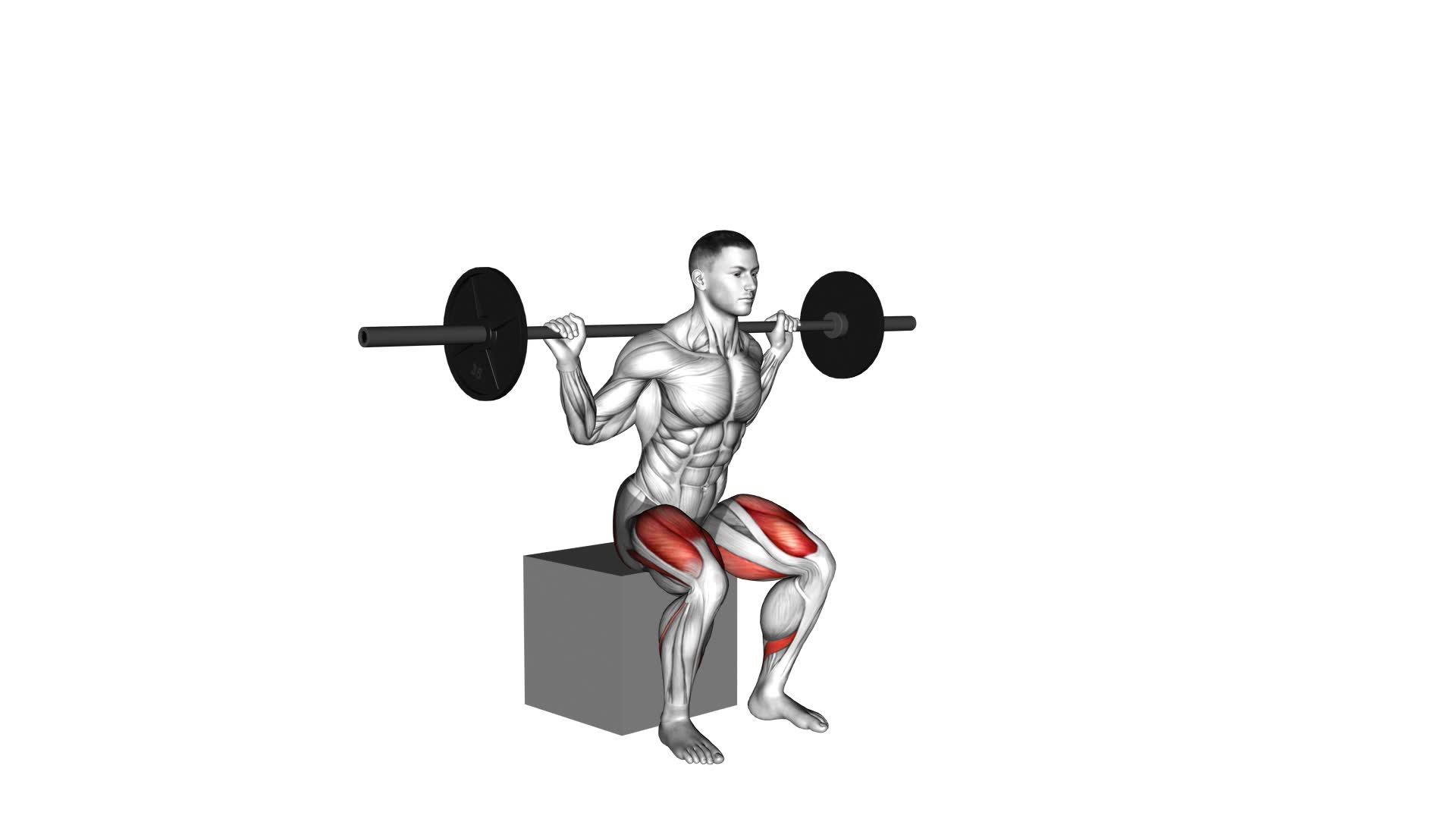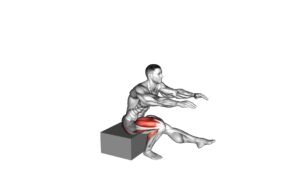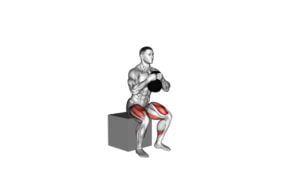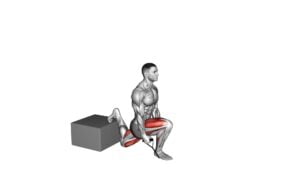Barbell Box Squat – Video Exercise Guide & Tips

Are you looking to improve your squat technique and build strength in your lower body? Then the barbell box squat is the exercise for you.
Watch This Exercise Video
In this video exercise guide, we'll show you the proper form and technique, as well as provide tips for a successful barbell box squat.
With the help of this guide, you'll be able to avoid common mistakes and make progress in no time.
Get ready to take your squats to the next level!
Key Takeaways
- The barbell box squat activates multiple muscle groups simultaneously, including the quadriceps, hamstrings, glutes, core, lower back, and calves.
- Proper form and technique, such as maintaining shoulder-width foot placement and proper alignment of hips and knees, are crucial for optimal results and to prevent injuries.
- The barbell box squat can be modified to target specific muscles and increase intensity, such as using different resistance levels or adjusting the height of the box.
- Gradually increasing the weight and continuously progressing in strength and technique can help improve results and prevent injury.
Benefits of the Barbell Box Squat
To maximize your strength gains and target your lower body muscles effectively, incorporate the barbell box squat into your workout routine.
The barbell box squat is a powerful exercise that offers several benefits. One of the main advantages of the barbell box squat is its ability to activate multiple muscle groups simultaneously. This exercise primarily targets your quadriceps, hamstrings, and glutes, but it also engages your core, lower back, and calves.
By incorporating barbell box squat modifications, such as changing the box height or using resistance bands, you can further target specific muscles and increase the intensity of your workout.
Additionally, the barbell box squat is a compound movement that mimics functional movements like sitting down and standing up. This makes it a highly practical exercise for everyday activities and sports performance.
Proper Form and Technique
To ensure proper form and technique during the barbell box squat, there are a few key points to keep in mind.
First, pay attention to your foot placement, ensuring that your feet are shoulder-width apart and pointing slightly outward.
Second, focus on maintaining proper alignment of your hips and knees throughout the movement, avoiding any inward or outward deviations.
Finally, practice proper breathing techniques, inhaling as you lower into the squat and exhaling as you push back up.
Foot Placement Tips
How should you position your feet for proper form and technique during the barbell box squat?
Foot placement techniques are crucial for maximizing stability and getting the most out of your squat. To start, stand with your feet shoulder-width apart and toes pointed slightly outward. This stance provides a solid base of support and allows for proper alignment of the knees and hips.
As you descend into the squat, make sure to keep your weight centered on your heels. This helps to engage your glutes and hamstrings, while also preventing your knees from going too far forward.
By maintaining proper foot placement, you can ensure proper form and technique, setting yourself up for a successful barbell box squat.
Now let's move on to discussing the importance of hip and knee alignment.
Hip and Knee Alignment
Maintain proper alignment of your hips and knees to ensure proper form and technique during the barbell box squat. Proper hip and knee alignment is crucial for maximizing muscle activation and minimizing the risk of injury.
Good hip mobility allows for a deep squat and prevents excessive stress on the knees. To achieve this, start by standing with your feet shoulder-width apart, toes slightly turned out. As you descend into the squat, focus on pushing your hips back and keeping your knees in line with your toes.
Avoid letting your knees collapse inward or flare outward, as this can put strain on the knee joint. Engage your glutes and quads to maintain stability and control throughout the movement.
Breathing Techniques
As you continue with the barbell box squat, it's important to focus on your breathing techniques to maintain proper form and technique. Proper breathing can help you engage your core muscles, stabilize your body, and generate power during the exercise.
When performing the barbell box squat, take a deep breath in before starting the descent. As you lower your body down, exhale slowly, focusing on pushing the air out and engaging your core. This technique will help you maintain stability and control throughout the movement.
Remember to inhale again at the top of the squat before starting the next repetition. By incorporating proper breathing techniques, you can optimize your performance and reduce the risk of injury.
Now, let's move on to the next section about equipment and set-up.
Equipment and Set-Up
To ensure proper barbell placement, position the barbell across your upper back, resting on your traps. Remember to take essential safety precautions by using a rack or spotter and adjusting the weight to your fitness level.
To optimize your squat technique, maintain a stable and comfortable stance, engage your core, and focus on keeping your knees aligned with your toes throughout the movement.
Proper Barbell Placement
Place the barbell securely on your upper back, using the appropriate equipment and set-up for a proper barbell box squat.
The barbell box squat is a versatile exercise that can be modified to suit different fitness levels and goals. Variations of the barbell box squat include using different box heights, wide or narrow stances, and incorporating bands or chains for added resistance.
This exercise offers numerous benefits, such as strengthening your lower body muscles, improving squat technique and form, and increasing overall strength and power. By properly placing the barbell on your upper back, you ensure stability and support during the exercise. This is essential for maintaining proper form and preventing injuries.
Now that you understand the proper barbell placement, let's move on to essential safety precautions.
Essential Safety Precautions
Make sure you have the appropriate equipment and set-up in place to ensure your safety during the barbell box squat. Proper equipment and set-up are essential for a safe and effective workout.
When performing the barbell box squat, it's important to use a sturdy and stable box that can support your body weight. The box should be set at a height that allows you to reach parallel or slightly below parallel when you squat down.
Additionally, make sure that the barbell is securely loaded and that the weights are evenly distributed on both sides. This will help prevent the barbell from tipping or rolling during the exercise.
Always check the integrity of the equipment before starting your workout to avoid any accidents or injuries.
Optimizing Squat Technique
When optimizing your squat technique for the barbell box squat, ensure that you have the correct equipment and set-up in place to maintain safety and effectiveness.
Improving mobility and increasing strength are key components of optimizing your squat technique. To improve mobility, consider incorporating exercises such as hip and ankle mobility drills into your warm-up routine. This will help you achieve a deeper squat position and prevent injuries.
In terms of equipment, make sure you have a sturdy box or platform at the appropriate height to support your weight. Additionally, use a barbell with proper weight and grip to ensure stability.
Proper set-up includes maintaining a neutral spine, engaging your core, and positioning your feet shoulder-width apart.
Progression and Variation
To progress and vary your barbell box squat, consider incorporating different resistance levels and adjusting the height of the box. This will challenge your muscles in new ways and prevent your workout from becoming stagnant.
Here are some progression techniques and advanced variations to keep your barbell box squat routine exciting and effective:
- Resistance Bands: Attach resistance bands to the barbell, increasing the tension as you squat. This adds an extra challenge to your muscles, forcing them to work harder throughout the movement.
- Weighted Vest: Wear a weighted vest while performing the barbell box squat. This will increase the load on your muscles, making the exercise more challenging and helping to build strength and endurance.
- Single-Leg Box Squat: Instead of using both legs, perform the box squat with one leg at a time. This variation requires greater stability and engages your core muscles more effectively.
- Pause Squat: Add a pause at the bottom of the squat, holding the position for a few seconds before returning to the starting position. This increases time under tension and enhances muscle growth.
Incorporating these progression techniques and advanced variations won't only keep your workouts interesting, but also help you achieve greater strength, stability, and muscle development.
Remember to always start with lighter weights and gradually increase the intensity as you become more comfortable and confident in your form and technique.
Common Mistakes to Avoid
To ensure proper form and maximize the effectiveness of your barbell box squat, it's important to be aware of common mistakes that should be avoided. By avoiding these common mistakes, you can prevent injury and optimize your workout results.
One common mistake is allowing your knees to cave inwards during the squat. This can put excessive stress on your knees and lead to discomfort or injury. To avoid this, focus on pushing your knees outwards as you squat down.
Another mistake to avoid is rounding your lower back. This can strain your spine and lead to lower back pain. Instead, keep your chest lifted and your back straight throughout the movement.
Lastly, it's important to avoid using excessive weight that you can't handle. This can compromise your form and increase the risk of injury. Start with a weight that challenges you but still allows you to maintain proper form.
Tips for a Successful Barbell Box Squat
To ensure success with your barbell box squat, focus on maintaining proper form, engaging your core, and using controlled movements. Here are some tips to help you perform this exercise effectively:
- Keep your chest up and maintain a neutral spine throughout the movement. This will help you avoid common errors such as rounding your back or leaning too far forward.
- Engage your core by bracing your abs and squeezing your glutes. This will provide stability and support during the squat.
- Control the descent by lowering yourself onto the box in a slow and controlled manner. Avoid simply dropping onto the box, as this can put unnecessary stress on your joints.
- As you drive up from the box, focus on pushing through your heels and activating your glutes and quads. This will help you maintain balance and power throughout the movement.
For those looking for advanced modifications, you can try adding resistance bands or chains to the barbell to increase the intensity of the exercise. This will challenge your muscles in new ways and help you continue to progress in your strength training journey. Remember to start with lighter weights and gradually increase the load as you become more comfortable with the exercise.
Frequently Asked Questions
How Much Weight Should I Start With When Performing a Barbell Box Squat?
When starting the barbell box squat, it's important to choose an appropriate starting weight. Begin with a weight that challenges you but allows for proper form and technique.
Can the Barbell Box Squat Help Improve My Vertical Jump?
The barbell box squat is a great exercise for basketball players looking to improve their vertical jump. By incorporating this exercise into your training routine, you can reap the benefits of increased explosive power.
The barbell box squat targets the muscles used in jumping and helps to build strength and power in your lower body. Regularly performing this exercise can lead to significant improvements in your vertical jump, allowing you to elevate higher on the court.
Are There Any Modifications or Adaptations for People With Knee or Hip Issues?
If you have knee or hip issues, there are modifications and adaptations you can make to the barbell box squat. By adjusting the height of the box and the depth of your squat, you can reduce stress on your joints while still benefiting from the exercise.
Barbell box squats can be particularly beneficial for rehabilitation, as they help strengthen the muscles around the knee and hip, promoting stability and improving overall function.
How Often Should I Include Barbell Box Squats in My Workout Routine?
To determine the frequency of barbell box squats in your workout routine, consider your goals and current fitness level. Including them 2-3 times a week can provide numerous benefits.
Barbell box squats are great for building lower body strength, improving squat form, and increasing explosiveness. They also target the glutes, hamstrings, and quadriceps.
However, it's important to listen to your body and give yourself enough rest between sessions to avoid overtraining. Consult with a fitness professional for personalized guidance.
Can the Barbell Box Squat Help Improve My Overall Athletic Performance?
The barbell box squat is a great exercise to improve your overall athletic performance. It offers numerous benefits for powerlifting, such as increasing lower body strength and explosiveness.
To execute it properly for maximum results, start by setting up a box at the desired height. Then, position yourself under the barbell, engage your core, and squat down until your hips touch the box.
Conclusion
In conclusion, the barbell box squat is a highly effective exercise that offers numerous benefits for strength and muscle development. By following proper form and technique, using the right equipment and set-up, and progressing and varying the exercise, you can maximize your results.
Avoiding common mistakes and applying these tips will ensure a successful barbell box squat. Incorporating this exercise into your workout routine can help you achieve your fitness goals.

Author
Years ago, the spark of my life’s passion ignited in my mind the moment I stepped into the local gym for the first time. The inaugural bead of perspiration, the initial endeavor, the very first surge of endorphins, and a sense of pride that washed over me post-workout marked the beginning of my deep-seated interest in strength sports, fitness, and sports nutrition. This very curiosity blossomed rapidly into a profound fascination, propelling me to earn a Master’s degree in Physical Education from the Academy of Physical Education in Krakow, followed by a Sports Manager diploma from the Jagiellonian University. My journey of growth led me to gain more specialized qualifications, such as being a certified personal trainer with a focus on sports dietetics, a lifeguard, and an instructor for wellness and corrective gymnastics. Theoretical knowledge paired seamlessly with practical experience, reinforcing my belief that the transformation of individuals under my guidance was also a reflection of my personal growth. This belief holds true even today. Each day, I strive to push the boundaries and explore new realms. These realms gently elevate me to greater heights. The unique combination of passion for my field and the continuous quest for growth fuels my drive to break new ground.







